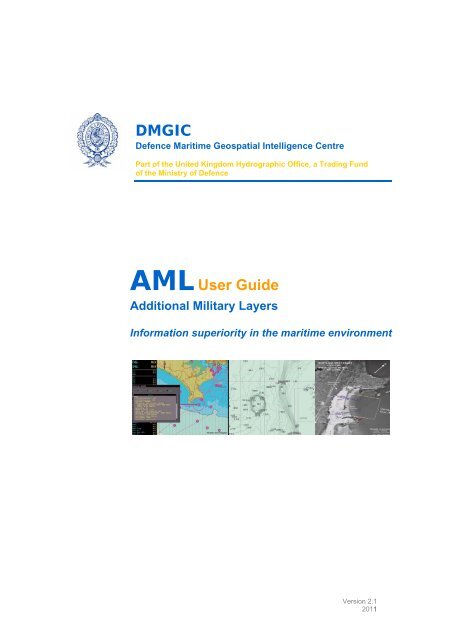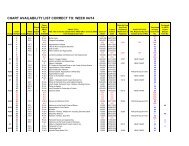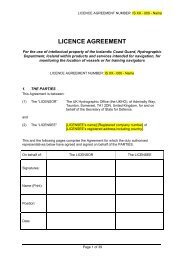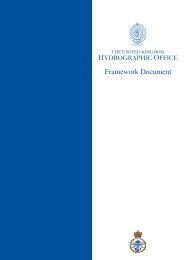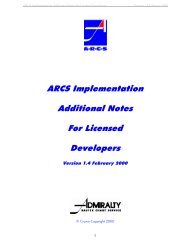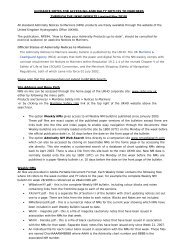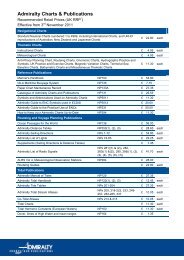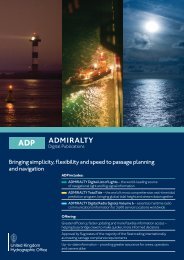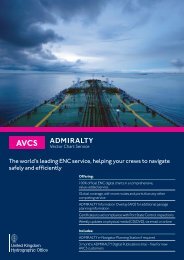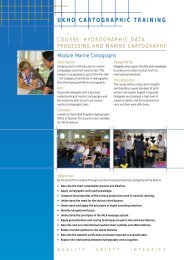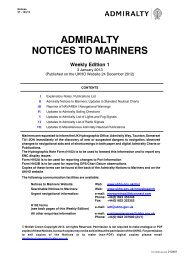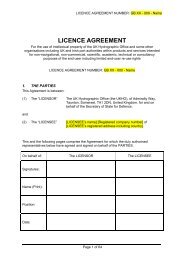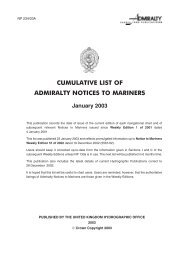the New AML User Guide - United Kingdom Hydrographic Office
the New AML User Guide - United Kingdom Hydrographic Office
the New AML User Guide - United Kingdom Hydrographic Office
Create successful ePaper yourself
Turn your PDF publications into a flip-book with our unique Google optimized e-Paper software.
DMGIC<br />
Defence Maritime Geospatial Intelligence Centre<br />
Part of <strong>the</strong> <strong>United</strong> <strong>Kingdom</strong> <strong>Hydrographic</strong> <strong>Office</strong>, a Trading Fund<br />
of <strong>the</strong> Ministry of Defence<br />
<strong>AML</strong> <strong>User</strong> <strong>Guide</strong><br />
Additional Military Layers<br />
Information superiority in <strong>the</strong> maritime environment<br />
Version 2.1<br />
2011
2<br />
UNCLASSIFIED 09/08/2012<br />
DMGIC<br />
© British Crown Copyright 2012
<strong>AML</strong> USER GUIDE<br />
This <strong>User</strong> <strong>Guide</strong> is provided for UK users of <strong>AML</strong>, but may be useful for o<strong>the</strong>rs.<br />
We welcome your comments or contributions to tips for users:<br />
Please contact aml@ukho.gov.uk<br />
For technical help and access to <strong>the</strong> <strong>AML</strong> Global CD<br />
Please contact Fleet Information Management Unit at:<br />
FLEET-N6FIMUGEO4@mod.uk<br />
Telephone: +44 (0) 2392 212240<br />
<strong>AML</strong> Catalogues<br />
There are three separate catalogues available showing current <strong>AML</strong> coverage:<br />
• Standard Catalogue of <strong>AML</strong> designed for use in WECDIS, WAIS, DNA2 and o<strong>the</strong>r <strong>AML</strong><br />
Capable systems.<br />
• WVS – World Vector Shoreline - Catalogue showing <strong>the</strong> <strong>AML</strong> coverage optimised for<br />
ADAWS<br />
The standard and WVS catalogues are supplied in one document.<br />
• Environment Risk Management Capability Catalogue showing <strong>AML</strong> coverage optimised<br />
for S2117<br />
Catalogues are provided in paper and digital formats by UKHO.<br />
3<br />
UNCLASSIFIED 09/08/2012<br />
DMGIC<br />
© British Crown Copyright 2012
4<br />
UNCLASSIFIED 09/08/2012<br />
DMGIC<br />
© British Crown Copyright 2012
INTRODUCTION<br />
<strong>AML</strong> - Additional Military Layers - was introduced to replace <strong>the</strong> need for specialist paper charts<br />
and overlays in order to meet <strong>the</strong> RN aims for <strong>the</strong> paperless bridge. The purpose of <strong>the</strong><br />
products is to enhance operational effectiveness in <strong>the</strong> maritime and littoral environments<br />
through superior situational awareness. At present 10 NATO members are actively involved in<br />
ei<strong>the</strong>r producing or using <strong>AML</strong> while o<strong>the</strong>r defence forces interested in <strong>the</strong>ir application include<br />
<strong>the</strong> US Department of Defence, <strong>the</strong> Royal Australian and Swedish Navies. Within <strong>the</strong> UK <strong>the</strong>y<br />
are produced by UKHO Taunton in support of <strong>the</strong> Recognised Environmental Picture (REP),<br />
part of ISTAR Network-Enabled Capability (NEC).<br />
The underlying concept of <strong>AML</strong> is to replace <strong>the</strong> need for reference to environmental information<br />
contained within specialist legacy printed publications by embedding it within databases that can<br />
be displayed on electronic systems, <strong>the</strong>reby enhancing situational awareness and tactical<br />
decision making. Within <strong>the</strong> Royal Navy <strong>AML</strong> is intended for display on WECDIS, WAIS,<br />
JC2SP, DNA2 as well as non-surface combatant command systems (e.g. MERLIN Tactical<br />
Command System).<br />
<strong>AML</strong> is distributed by FIMU to all RN ships and submarines in <strong>the</strong> form of a Global <strong>AML</strong> CD and<br />
are supported by <strong>the</strong> CSS-based UK <strong>AML</strong> Catalogue and NP114 NATO <strong>AML</strong> Catalogue (to be<br />
replaced by NATO <strong>AML</strong> e-Catalogue).<br />
THE BENEFITS OF <strong>AML</strong><br />
<strong>AML</strong> provides enhanced operational effectiveness through information superiority. Designed for<br />
situational awareness, <strong>AML</strong> supports digital navigation within WECDIS to greatly enhance <strong>the</strong><br />
manoeuvrability, access and reach of maritime forces.<br />
<strong>AML</strong> provides:<br />
• Unified data in one place<br />
• Attributed and searchable data<br />
• Rapid display<br />
• Selectable data<br />
• Can be displayed with o<strong>the</strong>r geospatial information<br />
• Interoperability with NATO nations<br />
• Format standardisation<br />
5<br />
UNCLASSIFIED 09/08/2012<br />
DMGIC<br />
© British Crown Copyright 2012
<strong>AML</strong> Types<br />
<strong>AML</strong> is divided into <strong>the</strong> following product types:<br />
Vector Products:<br />
• RAL – Routes, Areas & Limits (see Fig1.0)<br />
• CLB – Contour Line Bathymetry (see Fig2.0)<br />
• LBO – Large Bottom Objects (see Fig 3.0)<br />
• ESB – Environment, Seabed & Beach (see Fig 4.0)<br />
• MFF – Maritime Foundation & Facilities (see Fig 5.0)<br />
• SBO – Small Bottom Objects (see Fig 6.0)<br />
Gridded Products:<br />
• IWC – Integrated Water Column<br />
• AMC – Atmospheric and Meteorological Climatology<br />
• GS-ESB – Gridded Sediment ESB<br />
<strong>AML</strong> is not a navigational product and any navigation decision must be made with reference to<br />
<strong>the</strong> ENC. However some types of <strong>AML</strong> can be displayed with an ENC on a navigation system<br />
but fur<strong>the</strong>r guidance should be obtained from BR45.<br />
Routes, Areas and Limits - RAL<br />
Intended for Planning and in <strong>the</strong>atre Situational Awareness:<br />
Main features:<br />
• PEXAS / Exercise Grids<br />
• SM Transit Lanes<br />
• Fishery Limits<br />
• Patrol Areas<br />
• Stovepipes / Shipping Lanes<br />
• Territorial Water Limits<br />
• RAL can be displayed over ENCs<br />
• Maritime Protected Areas in support of MESAT (Maritime Environmental Sustainability<br />
and Assessment Tool)<br />
At present coverage for Territorial Waters limits within RAL cover <strong>the</strong> following regions*:<br />
• Eastern Mediterranean<br />
• Red Sea<br />
• Gulf of Aden<br />
• Persian Gulf<br />
• Caribbean<br />
* UKHO has a schedule of planned<br />
Territorial Waters <strong>AML</strong>; this priority can<br />
change if demand requires it.<br />
Fig 1.0 - Scale Band 0 Routes<br />
Areas and Limits Cell<br />
6<br />
UNCLASSIFIED 09/08/2012<br />
DMGIC<br />
© British Crown Copyright 2012
Contour Line Bathymetry - CLB<br />
CLB is intended for ASW operations showing higher density bathymetric information.<br />
Main Features:<br />
• Depth Areas<br />
• Depth Contour and Survey Reliability data<br />
• Soundings<br />
CLB should not be overlayed with an ENC in a navigational scenario. Products used for<br />
situational awareness do not have <strong>the</strong> same updating cycle as navigational products and<br />
may also be constructed from o<strong>the</strong>r source material. If viewed toge<strong>the</strong>r in a navigational<br />
scenario <strong>the</strong> resulting display could prove very misleading.<br />
Fig 2.0 - Scale band 4(1:1,000,000) Contour Line Bathymetry west of Scotland,<br />
useful for planning (Viewer – ECPINS, RN WECDIS)<br />
Large Bottom Objects - LBO<br />
LBO is an un-scaled product showing all objects on <strong>the</strong> sea bed greater than five metres in any<br />
direction.<br />
Main Features:<br />
• Wrecks (charted and uncharted)<br />
• Rocks<br />
• Obstructions<br />
• Seabed installations<br />
All objects are captured as point geometry. LBO includes information additional to that shown<br />
on standard navigational charts e.g. wrecks which are not significant to navigation.<br />
Each wreck depicted includes full attribution which cannot be shown on a standard chart making<br />
<strong>the</strong> data useful for submarine and anti-submarine operations and for mine warfare applications.<br />
7<br />
UNCLASSIFIED 09/08/2012<br />
DMGIC<br />
© British Crown Copyright 2012
Fig 3.0- Features from LBO (Viewer – ECPINS, RN WECDIS) alongside ENC.<br />
The attributes of a wreck can be seen in <strong>the</strong> display window.<br />
Environment Seabed and Beach – ESB<br />
Designed to provide <strong>the</strong> user with information about <strong>the</strong> sea bed and beach areas, ESB is of<br />
particular value in support of mine counter-measure activities and amphibious operations. It is a<br />
scaled product.<br />
Main Features:<br />
• Composition and thickness of multiple sediment layers including bedrock<br />
• Acoustic/physical properties<br />
• Slope<br />
• MCM areas<br />
• Sand waves<br />
• Trawl scours<br />
• Vegetation<br />
• Beach – full map/chart at very large scale, or as an overlay to standard mapping/charting<br />
• Low resolution seabed information to support ASW<br />
Fig 4.0 - Sediment Layer from ESB (Viewer – ECPINS, RN WECDIS).<br />
8<br />
UNCLASSIFIED 09/08/2012<br />
DMGIC<br />
© British Crown Copyright 2012
Maritime Foundation and Facilities - MFF<br />
MFF is a scaled product designed to provide a suitable reference background and context<br />
where standard electronic products such as ARCS or ENC are not used.<br />
Main Features:<br />
• Coastline<br />
• National boundaries and major cities<br />
• Main ports, harbour locations and facilities<br />
• Major lights and buoyage<br />
• Magnetic information<br />
• Tidal information<br />
• Radar reflective entities such as offshore platforms, buoys, beacons<br />
• Communication facilities and coverage<br />
• Pipeline and Cable information<br />
• Fishing activity<br />
• Oil, Gas and mineral production information<br />
• Ice limits<br />
• Search and rescue information<br />
• Miscellaneous sea bed obstructions that cover a significant area<br />
Fig 5.0 - Scale band 4MFF viewed with Scale Band 4CLB (Viewer – ECPINS, RN WECDIS)<br />
Small Bottom Objects- SBO<br />
Used by <strong>the</strong> mine warfare community, SBO is un-scaled and includes all known bottom contacts<br />
whose dimension is less than five metres in any direction. SBO is categorised into mines and<br />
mine-like contacts.<br />
9<br />
UNCLASSIFIED 09/08/2012<br />
DMGIC<br />
© British Crown Copyright 2012
Fig 6.0 - Fictitious sample Small Bottom Objects displayed alongside ENC (Viewer –<br />
ECPINS, RN WECDIS). The attributes of a mine have been queried.<br />
10<br />
UNCLASSIFIED 09/08/2012<br />
DMGIC<br />
© British Crown Copyright 2012
LOADING TIPS<br />
The display settings for viewing <strong>AML</strong> are important; individual features will not display if<br />
<strong>the</strong> settings are incorrect.<br />
Recommended settings for <strong>AML</strong> within WECDIS/WAIS –Version 5.3.1<br />
Colour Scheme -<br />
OSL DAY HI or OSL NIGHT HI<br />
<strong>AML</strong> Feature Group Feature<br />
RAL – Category -<br />
<strong>AML</strong> Groups<br />
Displayed Features - Water-space Management<br />
Intelligence and Information (TW)<br />
Category -<br />
Viewing Groups<br />
Displayed Features - Cautionary Areas,<br />
Administrative Areas (TW)<br />
CLB – Category -<br />
Viewing Groups<br />
Displayed Features – Contour Labels, depths<br />
Contour Labels, Safety<br />
Contours, tides and Magnetic Data<br />
Water and Seabed features<br />
MFF – Category -<br />
Viewing Groups<br />
Displayed Features - Administrative Sources<br />
Conspicuous Landmarks<br />
Information Areas<br />
Lights<br />
Port Features<br />
Seabed/Obstructions<br />
Services (Pilots)<br />
Shore Features<br />
ESB – Category -<br />
<strong>AML</strong> Groups<br />
Displayed Features - Bottom Information<br />
Beach and Landing Information<br />
Intelligence and Information<br />
Category -<br />
Viewing Groups<br />
Displayed Features - Information Areas<br />
Major Coastal Features<br />
Natural Features<br />
Seabed and Obstructions<br />
Shore Features<br />
LBO - Category -<br />
<strong>AML</strong> Groups<br />
Displayed Features - Bottom Information<br />
Category -<br />
Viewing Groups<br />
Seabed and Obstructions<br />
11<br />
UNCLASSIFIED 09/08/2012<br />
DMGIC<br />
© British Crown Copyright 2012
Loading Sequence of <strong>AML</strong> into WECDIS/WAIS<br />
Insert <strong>AML</strong> disc into WECDIS/WAIS terminal.<br />
Begin install procedure as indicated below:<br />
Choose directory where <strong>AML</strong>s are being imported from i.e. CD drive.<br />
Single click on drive and click “Search for Charts” or double click on drive<br />
12<br />
UNCLASSIFIED 09/08/2012<br />
DMGIC<br />
© British Crown Copyright 2012
In <strong>the</strong> left hand window, all <strong>the</strong> products on <strong>the</strong> disc will be displayed. These will generally be<br />
displayed as exchange sets.<br />
Select or create a folder you wish to place <strong>the</strong> cells in.<br />
Double click on <strong>the</strong> exchange set e.g. UKCBU107. All <strong>the</strong> cells within <strong>the</strong> exchange set will<br />
appear in <strong>the</strong> “select charts” window.<br />
Click on “Select visible” <strong>the</strong>n “Install Charts”. This will install all <strong>the</strong> charts into <strong>the</strong> folder<br />
selected.<br />
A message informing you that all <strong>the</strong> cells have installed correctly will be visible.<br />
13<br />
UNCLASSIFIED 09/08/2012<br />
DMGIC<br />
© British Crown Copyright 2012
Once <strong>the</strong> <strong>AML</strong> cells have been installed, <strong>the</strong>y <strong>the</strong>n have to be loaded to view.<br />
In <strong>the</strong> main menu, click on chart selection <strong>the</strong>n as shown below “load charts”<br />
A loading window will appear as shown below.<br />
Choose <strong>the</strong> folder you wish to view contents of in left hand window.<br />
Double click on <strong>the</strong> cell you wish to view or click once and <strong>the</strong>n click load.<br />
14<br />
UNCLASSIFIED 09/08/2012<br />
DMGIC<br />
© British Crown Copyright 2012
Note: If when you load <strong>the</strong> cell an error message appears “Invalid Checksum”, this means <strong>the</strong>re<br />
is a problem with <strong>the</strong> Catalogue file. (The catalogue file is a text file generated when <strong>AML</strong> cells<br />
are packaged toge<strong>the</strong>r to form an exchange set. It is this file ECPINS (WECDIS) looks for when<br />
loading <strong>AML</strong> data to know, not only what cell it should be loading but also <strong>the</strong> geographic<br />
extents of <strong>the</strong>se cells).<br />
If <strong>the</strong> CATALOGUE file is not present ano<strong>the</strong>r error message appears “Note: Required<br />
CATALOG file(s) could not be found……” Without this file some <strong>AML</strong> cells i.e. RAL will still load<br />
but any additional components like those found in ESB i.e. photographs, beach gradient<br />
diagrams will not.<br />
IF EITHER OF THESE MESSAGES APPEARS, PLEASE CONTACT FIMU, HMS<br />
COLLINGWOOD OR DEFENCE SERVICE DELIVERY UKHO TAUNTON.<br />
FLEET-N6FIMUGEO@mod.uk<br />
Mws-wtg-necs@fleetfost.mod.uk<br />
aml@ukho.gov.uk<br />
Viewing Territorial Waters <strong>AML</strong><br />
15<br />
UNCLASSIFIED 09/08/2012<br />
DMGIC<br />
© British Crown Copyright 2012
In order to view Territorial Waters <strong>AML</strong> it is essential to use <strong>the</strong> correct settings.<br />
Example of Territorial Water Limits (TW)<br />
displayed in ECPINS, RN WECDIS<br />
showing <strong>the</strong> settings needed to view RAL (TW)<br />
<strong>AML</strong>.<br />
16<br />
UNCLASSIFIED 09/08/2012<br />
DMGIC<br />
© British Crown Copyright 2012
If you have user tips to share for <strong>the</strong> benefit of o<strong>the</strong>rs please contact aml@ukho.gov.uk<br />
The following user tip was provided by <strong>the</strong> NO of HMS Liverpool October 2011:<br />
Decryption: Currently <strong>the</strong> documentation states that <strong>the</strong> disk should be decrypted on a Bycrypt laptop,<br />
<strong>the</strong>n <strong>the</strong> <strong>AML</strong>s can be burnt to a CD to be installed on WECDIS. The process is smoo<strong>the</strong>r if you take<br />
softlock off WECDIS and decrypt <strong>the</strong> CD to a temporary folder on <strong>the</strong> D drive. Then all three WECDIS<br />
terminals can install <strong>the</strong> <strong>AML</strong>s from that location. The danger is that on completion you are using up disk<br />
space by having two copies of <strong>the</strong> <strong>AML</strong>s on <strong>the</strong> system, so <strong>the</strong> temporary folder needs to be deleted once<br />
<strong>the</strong> <strong>AML</strong>s are installed. This process also prevents a decrypted disk from needing to be destroyed.<br />
This tip was provided by <strong>the</strong> Navigator of HMS Illustrious October 2011<br />
By using a DII capable USB stick in <strong>the</strong> RPT (AES lock type) I can move <strong>the</strong> <strong>AML</strong>s into <strong>the</strong> WAIS<br />
terminals.<br />
17<br />
UNCLASSIFIED 09/08/2012<br />
DMGIC<br />
© British Crown Copyright 2012


